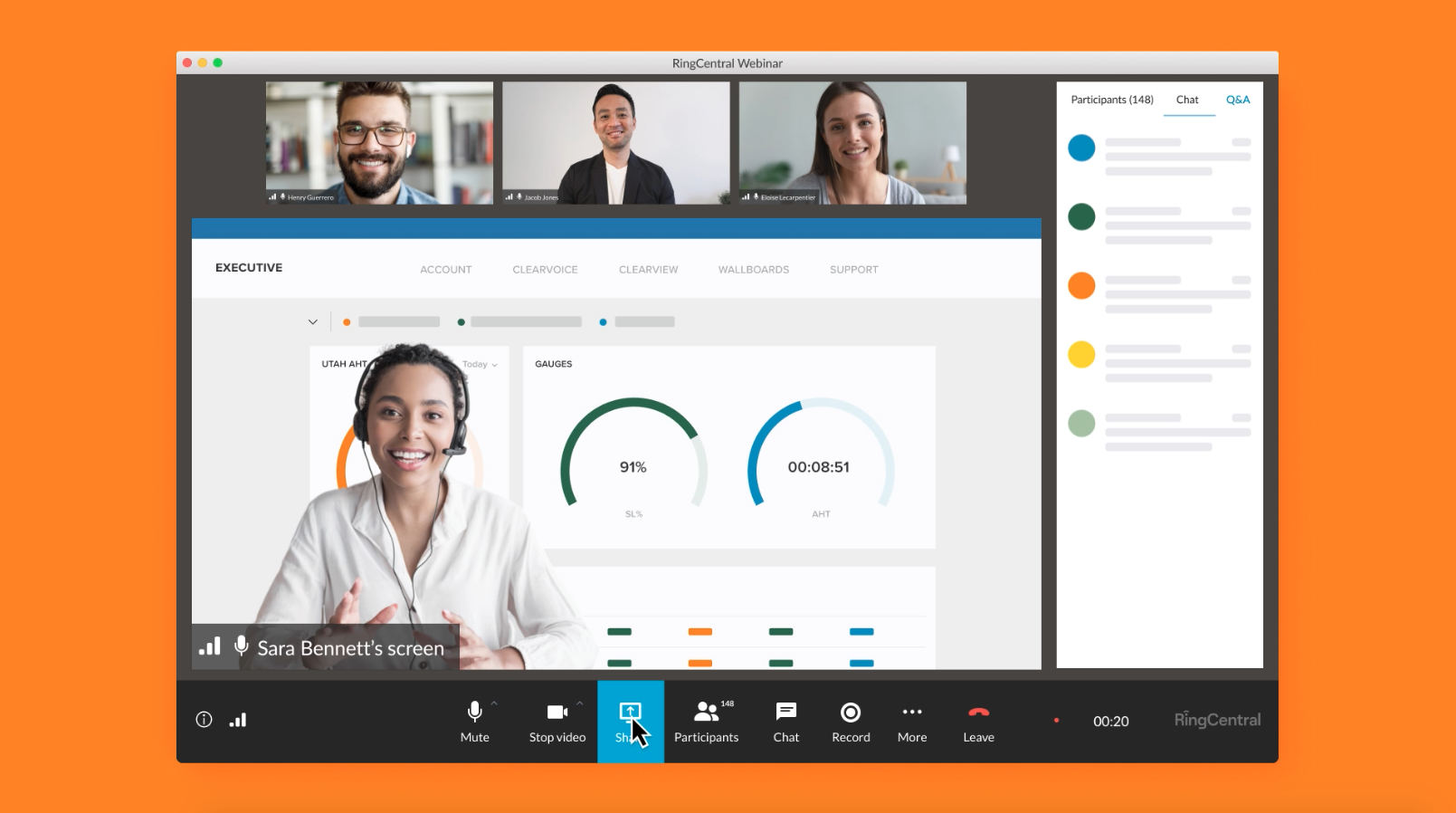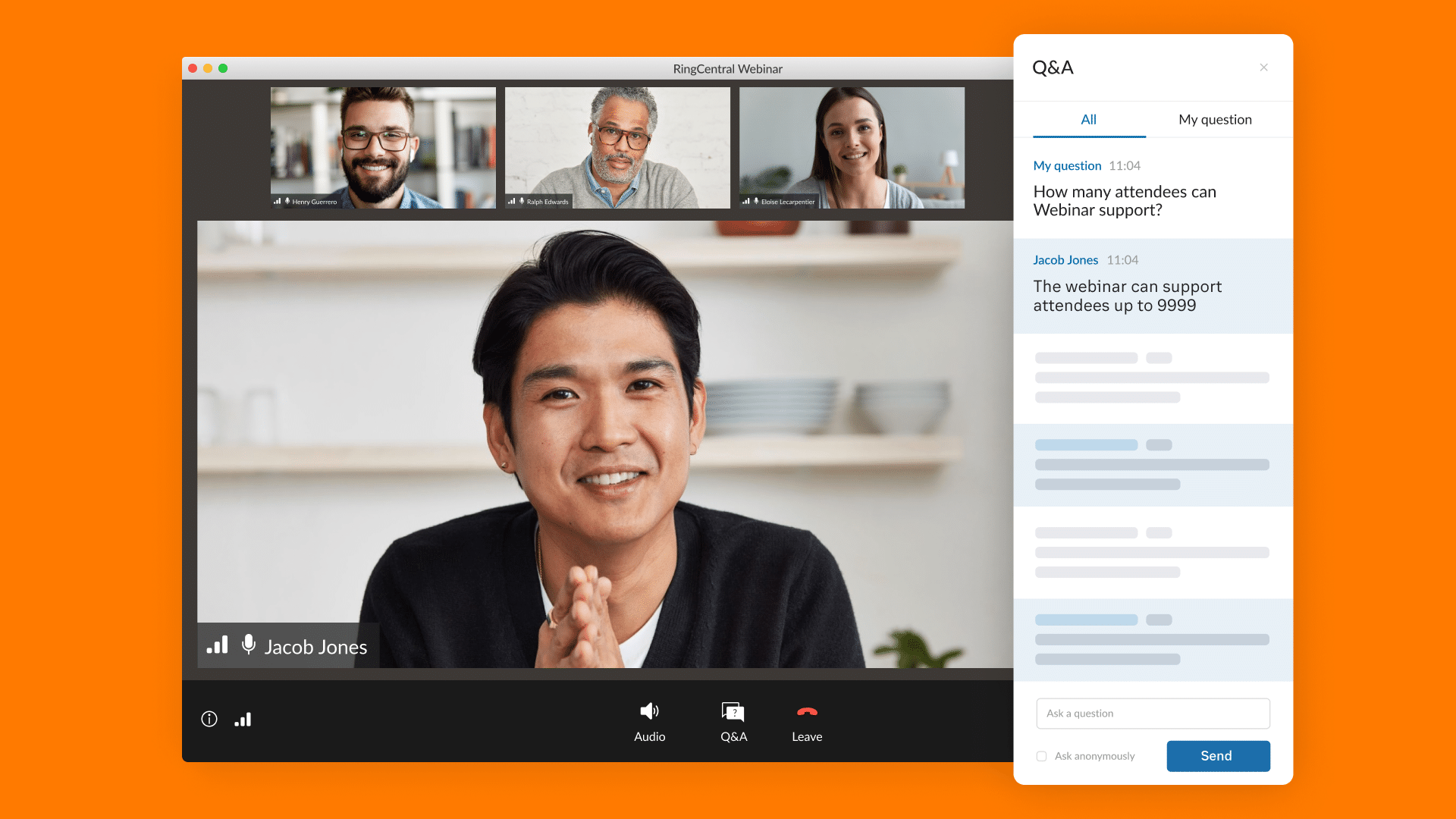If you’re here at 3 a.m., it’s likely because you had that dream again. The one where you’re at an in-person networking event, you walk up to somebody, introduce yourself, and then — blackout. The mind goes blank, and you have no idea what to say next.
Now, here you are — scrambling for in-person networking tips for an upcoming event — when you should be sleeping.
You may be a newcomer to in-person networking, a veteran attendee who’s still nervous, or a networking pro looking to sharpen your skills. Wherever your experience falls, this is your chance for a fresh mindset.
Instead of dwelling on the number of people you chat with, focus on building genuine relationships that leave you excited instead of drained.
Why it’s okay to talk to strangers
Despite what you heard as a kid, talking to strangers as an adult has clear benefits. A healthy network opens doors to opportunities and boosts careers. It is estimated that 46% of job seekers learn about open positions from friends, and 25% are looped in by professional connections.
While folks think first about professional benefits when it comes to networking, few realize that talking to strangers enhances their quality of life.
Nearly 62% of employed adults in the U.S. consider themselves lonely — a major blow to someone’s sense of well-being. In fact, love, belonging, and connectedness are right at the center of Maslow’s Hierarchy of Needs.
Often, folks feel, at once, overlooked and reluctant to strike up a conversation with someone new. It begs the question: Are people being left out, or are people getting in their own way?
If no one begins a conversation, then everyone shares responsibility for leaving out.
Why do people do this? For a few reasons. People avoid talking to strangers because they assume:
- The conversation will be awkward.
- They might not like each other.
- They simply won’t enjoy it.
All are understandable fears, but research indicates that talking to strangers has more benefits than drawbacks. For one, it is surprisingly informative. Not only will you gain new insights, but you’ll also get better at talking to strangers with each new conversation. Then, you can reap the health, social, and career benefits that go along with it.
To help fend off the awkwardness, refresh your social skills with this cheat sheet of in-person networking best practices — just in time for your next event.
Step 1: Make a captivating first impression
Sometimes showing up is the biggest hurdle. Maybe you feel it when walking into a room of strangers, initiating a conversation, or worrying there’s food between your teeth as you open your mouth to speak. You want to leave a good first impression — and that can be pretty darn intimidating. Its often why people prefer video calls as it feels less daunting.
But if you front-load some solutions, the networking experience can be less stressful.
Know your why
What motivated you to RSVP a yes in the first place? The answer will help determine your networking purpose. Do you want to:
- Get a job?
- Make a friend?
- Find a mentor?
- Join a community?
- Build your business?
- Connect with like-minded individuals?
Your answer also shapes how you interact with others. You might be more direct if you’re looking for a job. On the other hand, if you want to make a friend, you might focus on building rapport by chatting about shared interests.
Whatever the reason, if the event organizers share a list of attendees, note the people you want to meet who help fulfill your purpose. Finding them will be your first task when you arrive at the event. Then, when you’re ready to leave, you’ve already accomplished your top goal.
Make a game of it
Once you know your ‘why’, consider incentivizing yourself to meet a set number of people. For example, after talking to 10 people, treat yourself to a forest hike soon after the event — a hike with many trees and few people.
If you tend to be introverted or reluctant to engage, why not use gamification to motivate yourself? It works in the marketing and e-learning industries, so it might help you feel more confident, optimistic, and excited about mingling with strangers.
Rehearse some words
When we meet someone new, we want the other person to like us, and we don’t want to fumble over our words. Even the suavest people get flustered sometimes. Many people fret over starting conversations, keeping conversations flowing, and ending them when the time comes.
If those situations cause you to shut down, be proactive by having responses at the ready:
- Practice a two-sentence elevator speech that shares who you are and what you do.
- Note questions you might ask to keep a conversation on track.
- Plan replies to icebreakers that usually put you on the spot.
By practicing responses, you eliminate some of the heavy lifting required of your brain in the moment. This frees you up to focus on the other person, rather than thinking about what to say next.
Dress to impress
Stop playing a guessing game of “Suit versus Cardigan”, check the event description for clues about the dress code. Ask event organizers or veteran attendees for suggestions if it’s not specified. If no one knows, your safest option is business casual attire. When selecting your power outfit, consider these factors:
- Keep in mind industry norms for attire.
- Stand out in a memorable bright color.
- Wear a statement piece that serves as a conversation starter.
- Treat your feet to comfortable footwear if you’ll do a lot of standing.
- Dress for comfort, too. The last thing you want on your mind is an itchy sweater.
If time allows, lay the options out the night before so you’re not scrambling at the last minute. When event day rolls around, choose the outfit that feels most comfortable and confident so you can leave a lasting impression.
Hype yourself up
Even Beyoncé used an alter ego — Sasha Fierce — to boost her confidence before performances. Take some inspiration from her and create your own pre-event ritual. Turn up the volume on a mood-boosting playlist or take some cleansing breaths, and write this down, so you have a back-pocket pep talk for later:
- People like you more than you think.
- Conversations with strangers can teach you a lot.
- Most attendees feel equally as nervous (possibly more so).
- Relationships within a community could help you live longer.
It’s normal to feel both excited and nervous. Since adrenaline provides a performance boost, funnel the energy from the uneasiness to power through introductions with a smile.
Follow social norms
When you walk into the event space, look around to see what other people are doing. Industry and location social norms can dictate in-person networking events go, but these tips are universal among most industries and locales:
- Arrive on time.
- Pay attention to social cues.
- Make eye contact (but not too much).
- Keep conversations focused on the positive.
If you forget someone’s name or want clarification on how to pronounce it, politely ask for a reminder. Most appreciate the effort, and you won’t stumble over it for the rest of the event.
Step 2: Focus on learning about others
A wise mermaid once sang, you “wanna be where the people are.” So, hang near the bar or wherever folks gather. If that causes sensory overload, seek out people sitting alone or initiate a meetup. After all, they probably feel like you do.
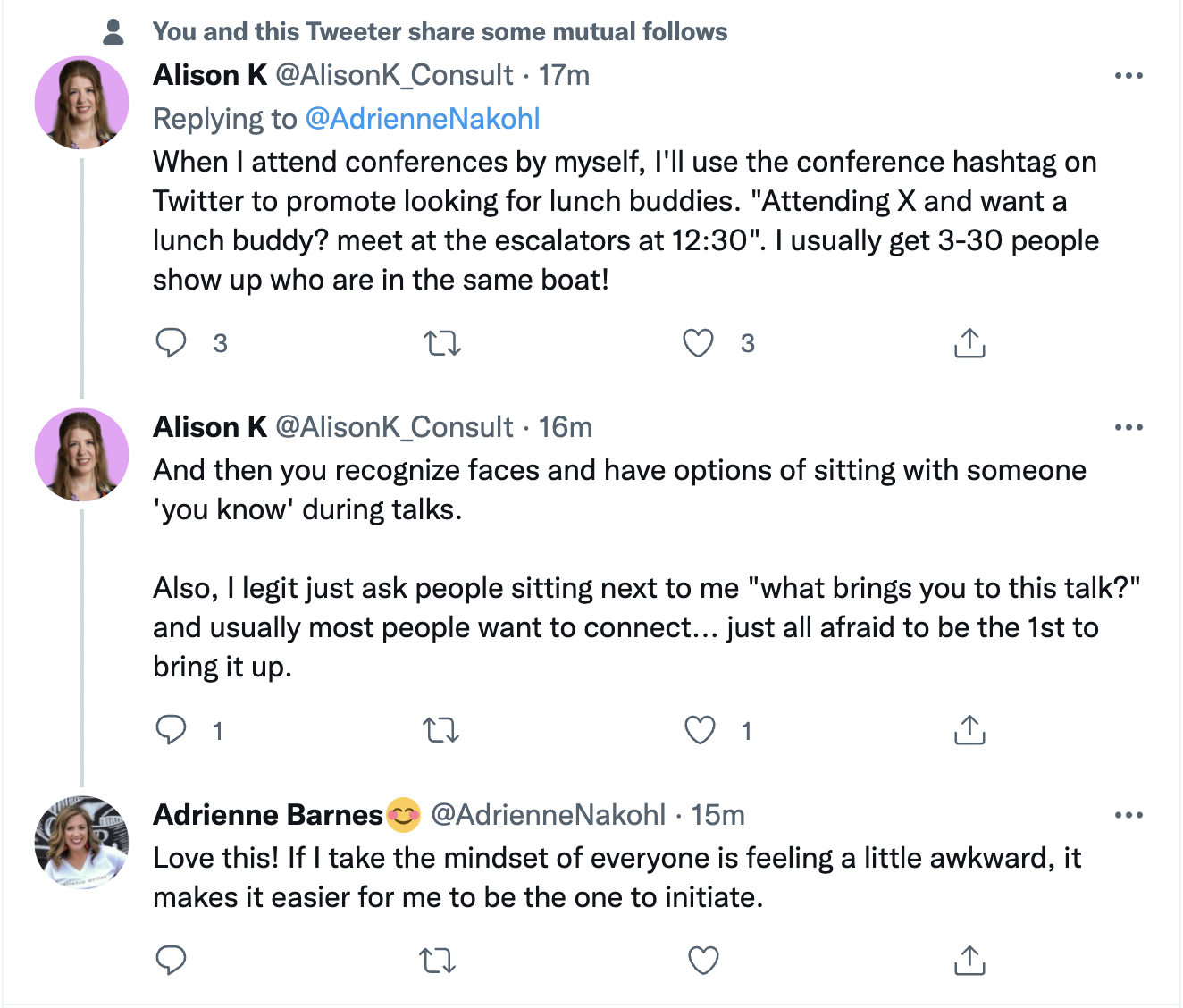
Whatever you do, resist hiding behind your phone. Sure, at least that way you feel like you are doing something instead of awkwardly sitting there, but it also makes you seem unapproachable.
Find and be a wingperson
Some folks prefer to navigate the event with a supportive friend. If talking about yourself feels uncomfortable, finding and being a wingperson might be the right strategy for you.
Before the event, ask friends and social media connections if they are attending. If so, recruit them to be your networking buddy and reciprocate. It’s often easier to champion someone else, and they likely feel the same.
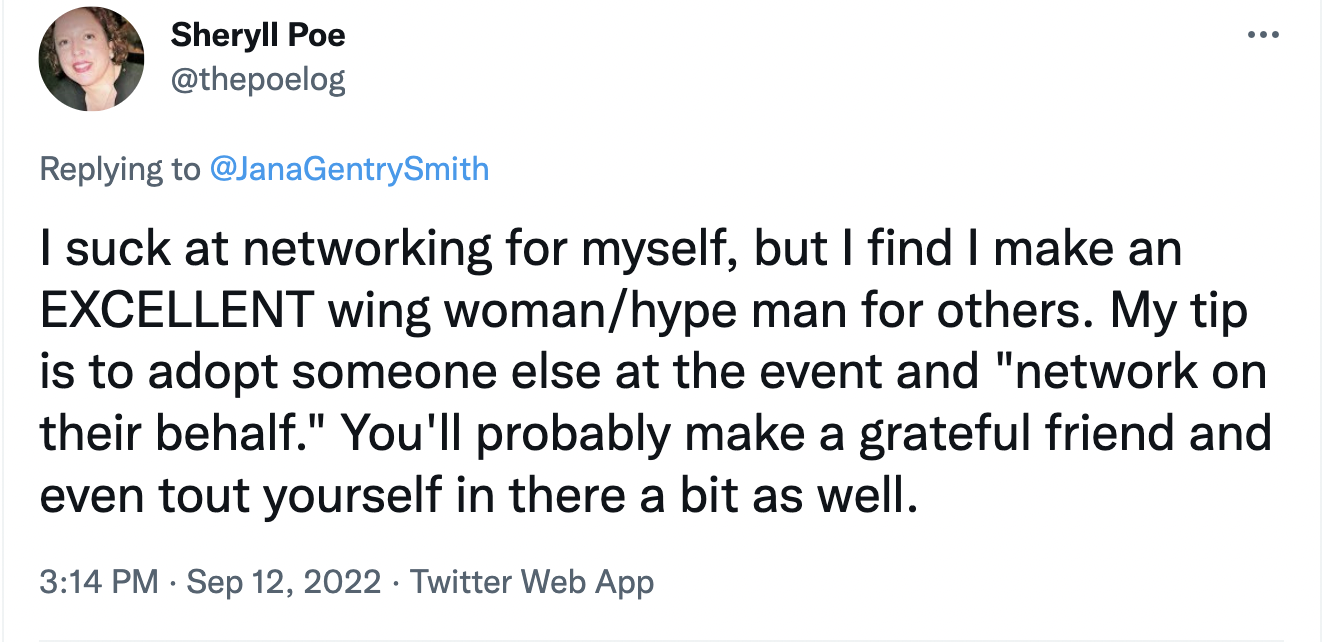
Also, when three or more people are involved in a conversation, one person can be “on” when the other’s energy begins to wane.
Use open-ended questions
If you learn one conversation tweak, let it be mastering the art of asking open-ended questions. They require answers that dig deeper than a simple yes or no answer because they usually begin with words like why, how, or what.
Then, ask follow-up questions to show interest and learn more. Some examples of good open-ended questions for in-person networking events are:
- How did you get interested in X?
- What are you working on right now?
- What has been your most rewarding experience in X?
- What are some of the challenges you’ve faced in X?
- What has been the biggest surprise in your experience with X?
And you’re not limited to work — questions about hobbies, pets, and travels are all fair game.
Curiosity leads to more successful conversations during in-person networking events, which ultimately results in meaningful connections.
Listen more than you speak
Active listening is more important in networking than being good with words. When you’re genuinely interested in what the other person is saying, it’s easier to resist urges to monopolize the conversation.
Maybe you have already mastered active listening, but your short-term memory is unreliable. If so, jot down notes about your conversations. Later, you can share sincere compliments or follow up because the contents of your discussion will be in front of you.
Often, actively listening reveals opportunities to use your skills or connections to help others achieve their goals.
Step 3: Share more of yourself
Begin by introducing yourself with your name and the short elevator speech you practiced before the event. If you have one, share an easy way to remember your name.
After chatting for a while, what happens if the conversation just isn’t flowing anymore? Pop culture was made for this moment — pop-culture references are widely known and fun to talk about. Consider brushing up on:
- Titles from The New York Times Best Seller list
- Popular TV shows
- Current Events
- Movies
- Sports
Be vulnerable
Sometimes, people put up emotional walls to protect themselves from harm. In recent years, public figures such as Brene Brown, Glennon Doyle, and Kim Scott have advocated for a revolution of vulnerability.
Most would agree that networking events are a vulnerable experience even though many feel exposed in these situations. Even so, embracing the awkwardness can ease the tension for everyone and foster stronger connections simply because you are experiencing the awkwardness together.
At times, people attempt to seem less vulnerable by being competitive, but it usually repels connections.
Instead, if someone shares an accomplishment, resist the urge to impress everyone with a more impressive accomplishment of your own. Instead of one-upmanship, compliment the person on their achievement and ask for pointers.
Not only are you showing vulnerability, but asking for advice is also a great way to build relationships. And people like to feel useful, so asking for a small favor fosters goodwill and a deeper connection.
Leave them wanting more
Once in a while, it’s tricky to know how and when to end a conversation. If you find yourself in a situation where you’re ready to move on, but your conversation partner is not, consider flashing a genuine smile and using one of these phrases:
- “I enjoyed catching up.”
- “It was great to meet you.”
- “Well, I’d better get back to X.”
- “Good luck with X. Let me know how it goes.”
- “What are you working on? I want to hear all about it. Let’s schedule a chat.”
These parting words serve as cliffhangers, so you can pick up the conversation where you left off the next time you speak.
Step 4: Stay connected
Prepare to follow up with your contacts during the networking event instead of waiting until it’s over. Since it’s tough to remember everyone’s name and face, ask to take photos of people and their nametags as you meet them. Then, future you can refer to the photos when it is time to follow up.
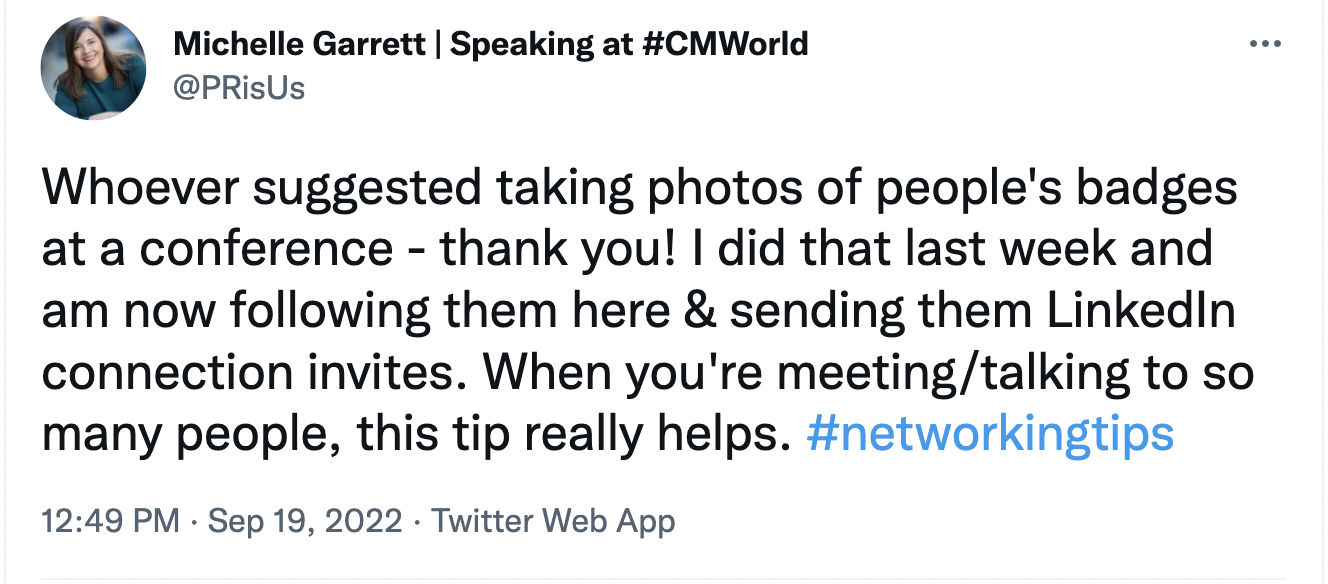
It’s also helpful to take notes while you’re at the event. While still fresh, jot down impressions of people you meet, topics you discuss, and details to help you remember them later. Then, you can refer to the photos and notes when writing follow-up emails or scheduling coffee chats.
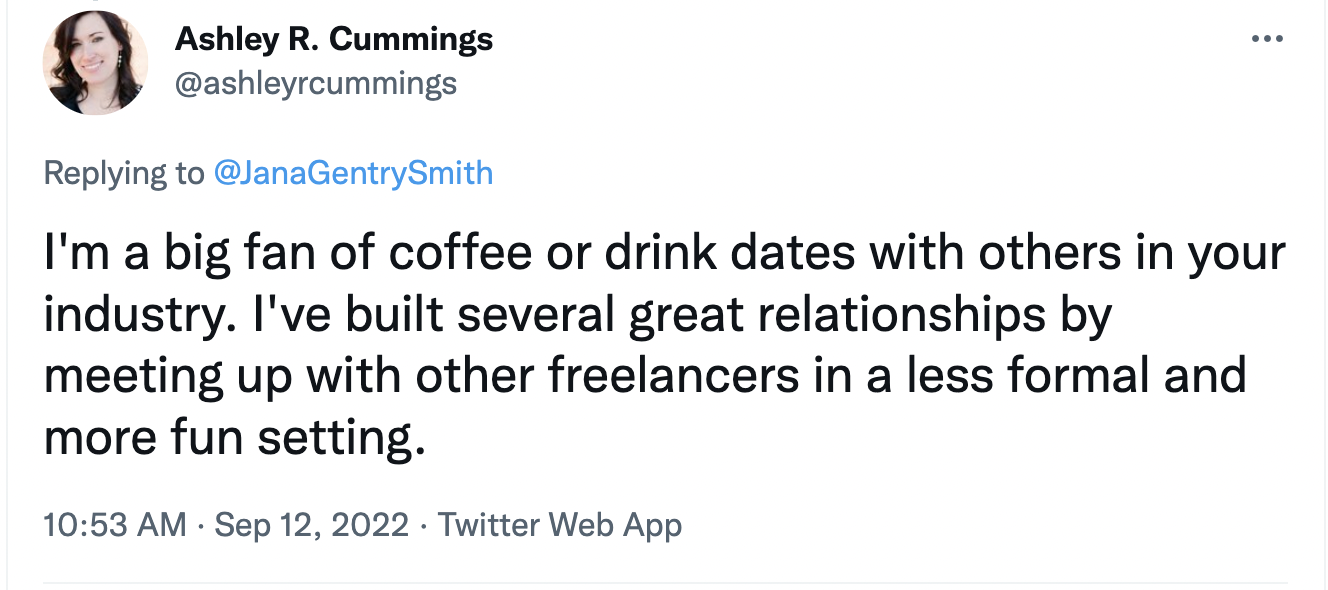
In-person coffee chats work if you live in the same city as the person you’re meeting, but virtual chats can be just as effective. By scheduling these meetings soon after the event, you’ll be more likely to create lasting connections.
Engage with the event community
“I’ll do it tomorrow” — sounds familiar enough. Keeping up with new acquaintances is easy to transfer to the next day’s to-do list — on repeat. Yet, staying active in the event community is key to maintaining the new acquaintances you made at the in-person networking event. Here are a few ways you can stay connected:
- Engage with others on the community’s virtual hub.
- Volunteer to organize regional events.
- Attend the community’s future events.
After attending an in-person networking event, a little schmoozing does wonders for nourishing relationships and cultivating your network. The longer you engage with a community, the more fulfilling connections you will make and the more comfortable you will feel attending future events — which means no more networking nightmares.
To speak to someone about how you can actually run an amazing networking event, book a meeting with the RingCentral Event Sales team.
Originally published Sep 01, 2022, updated Oct 20, 2024



